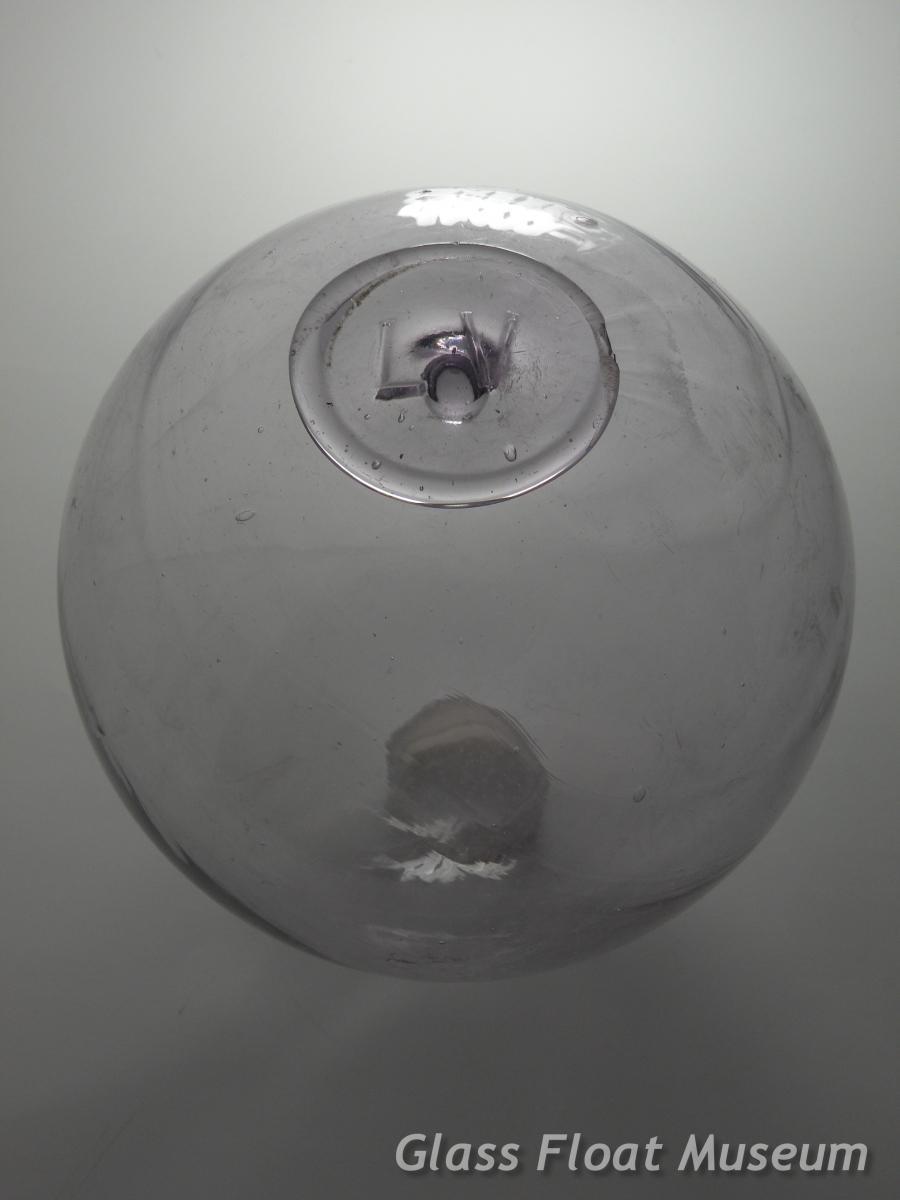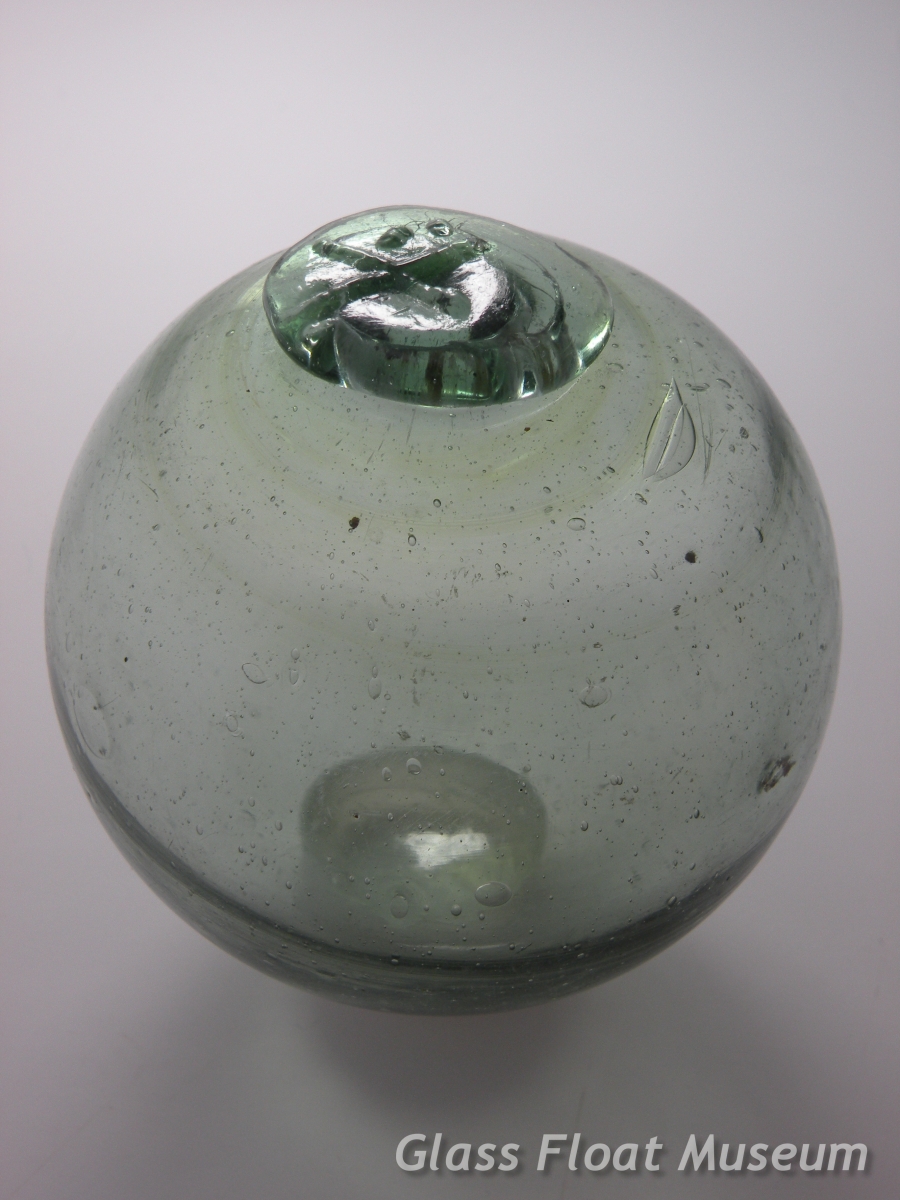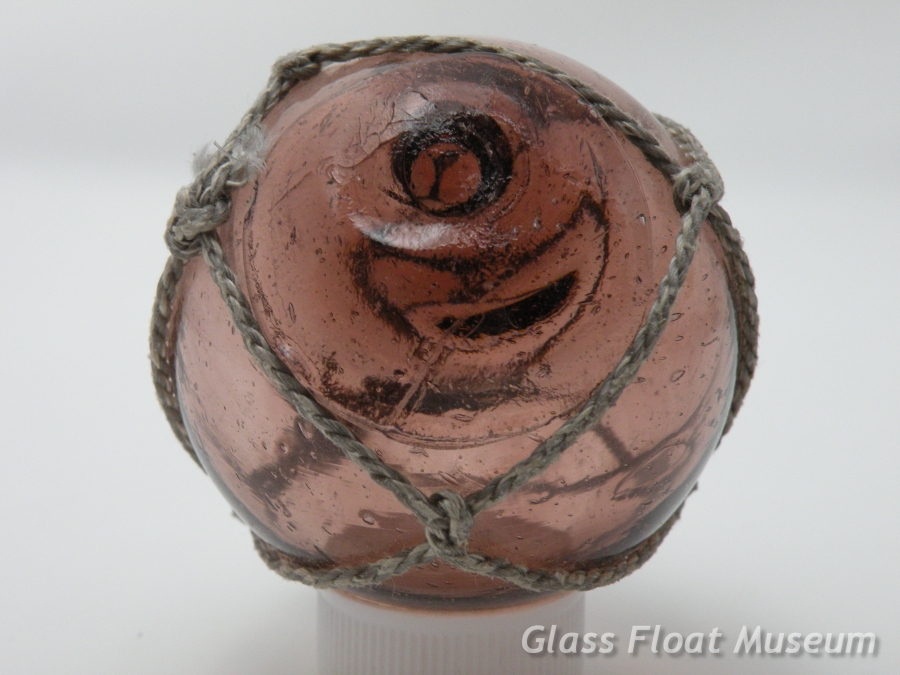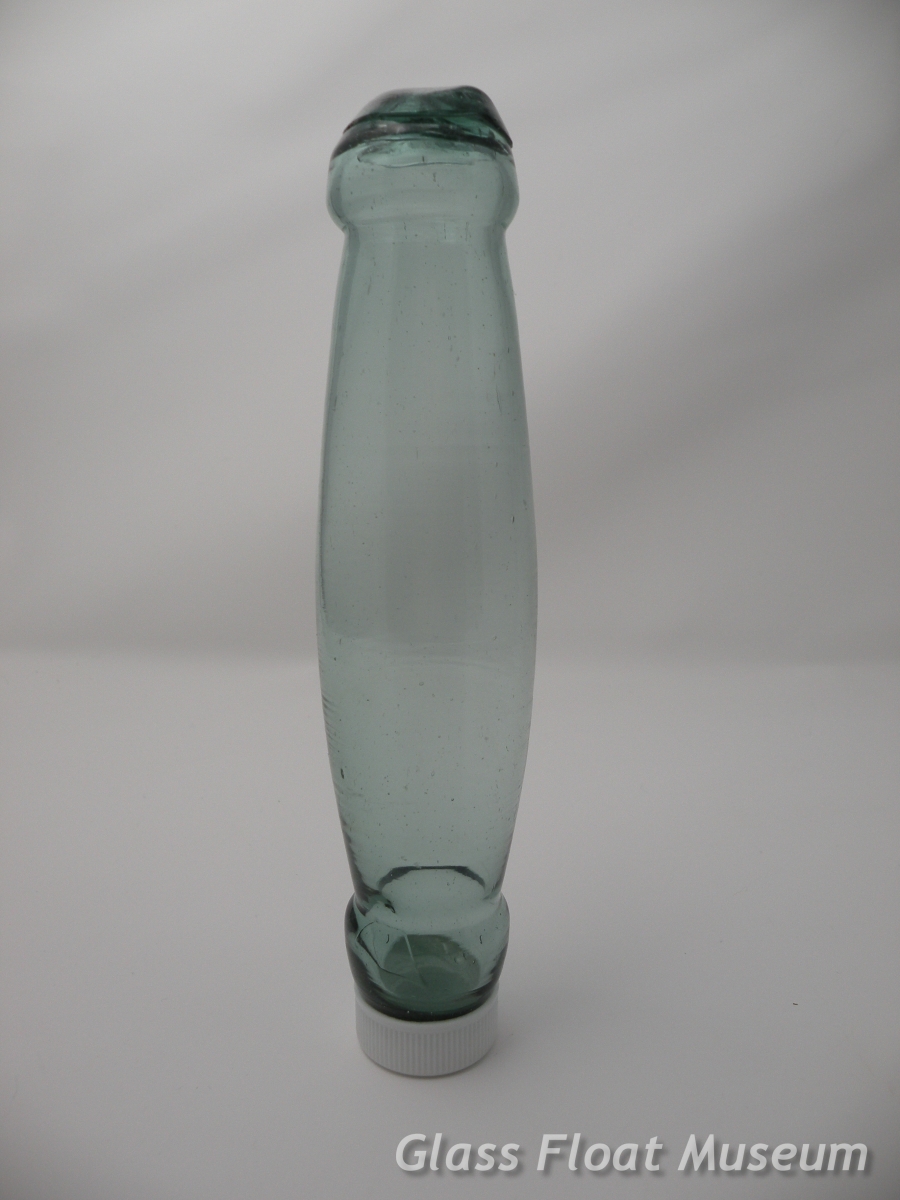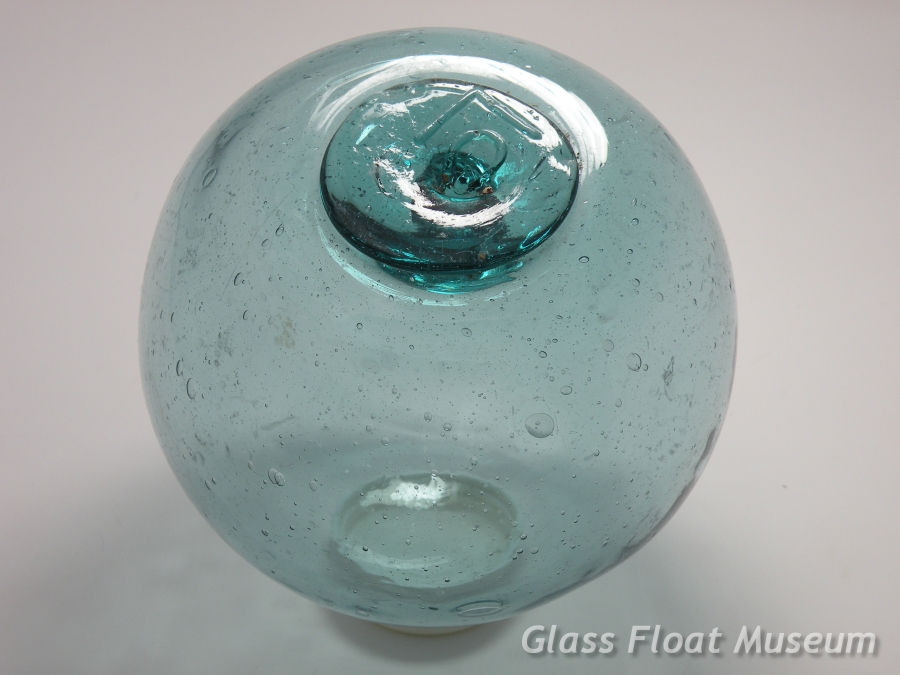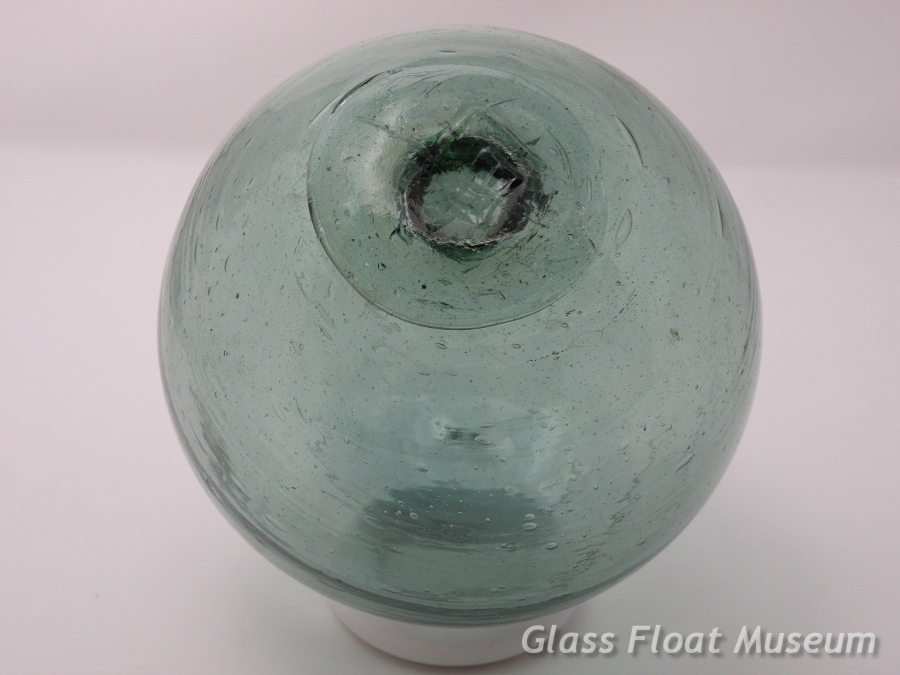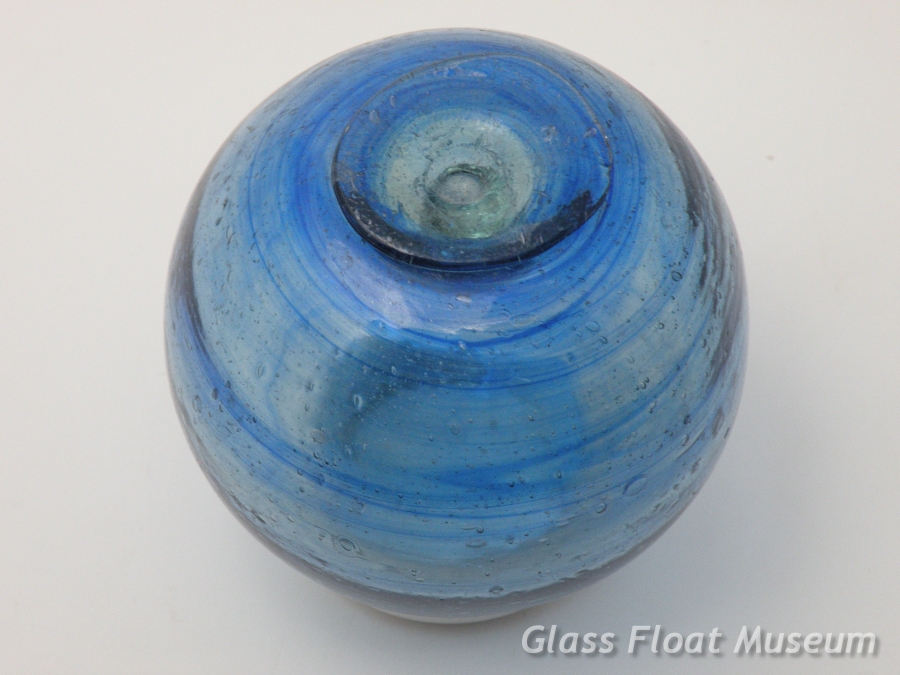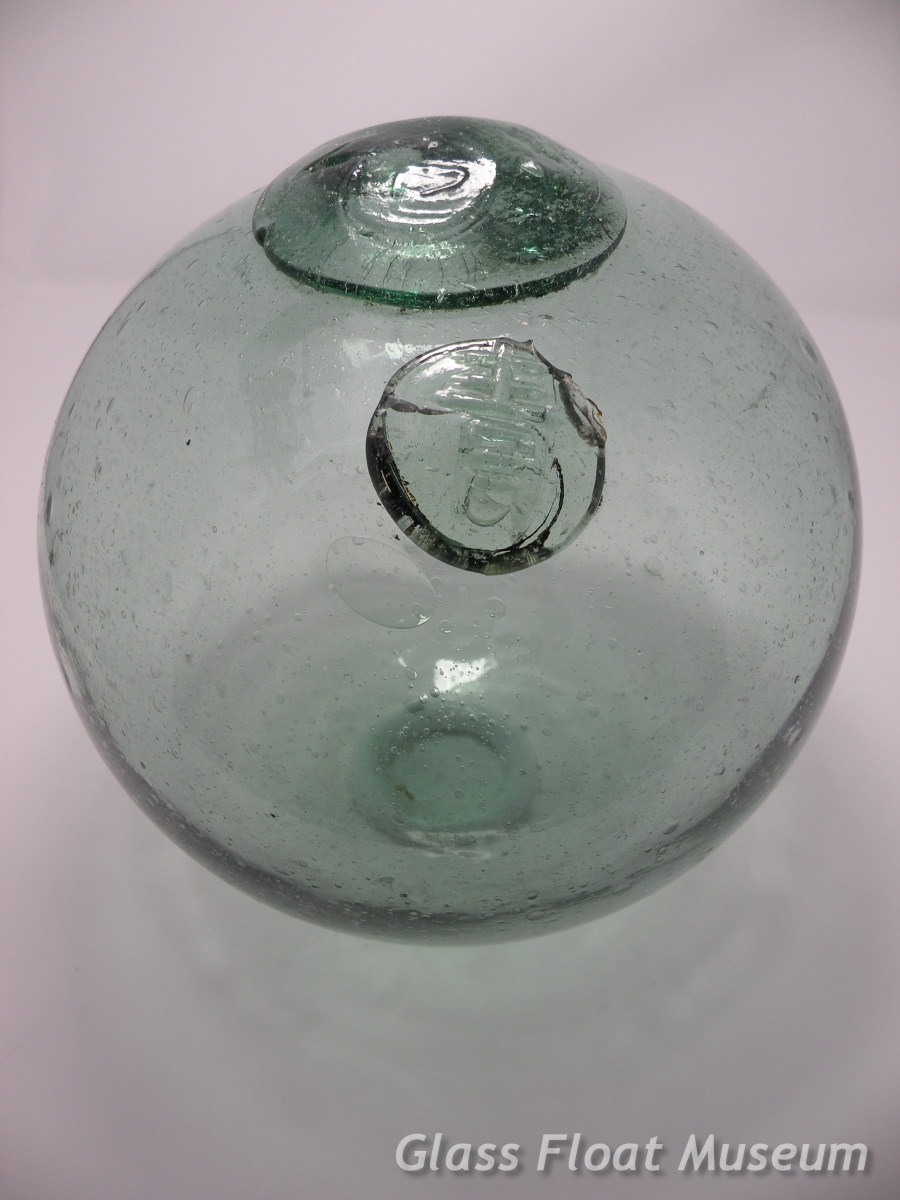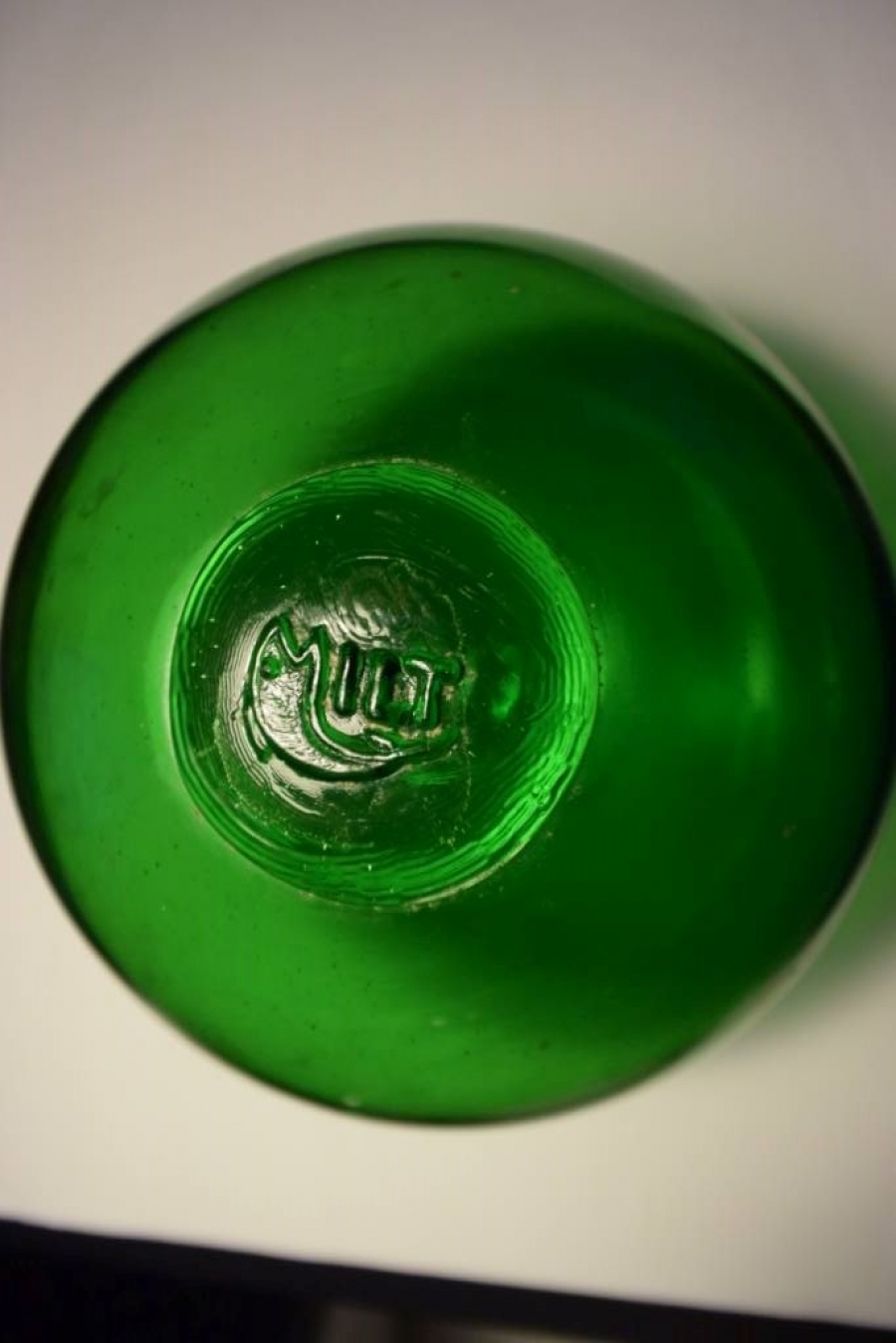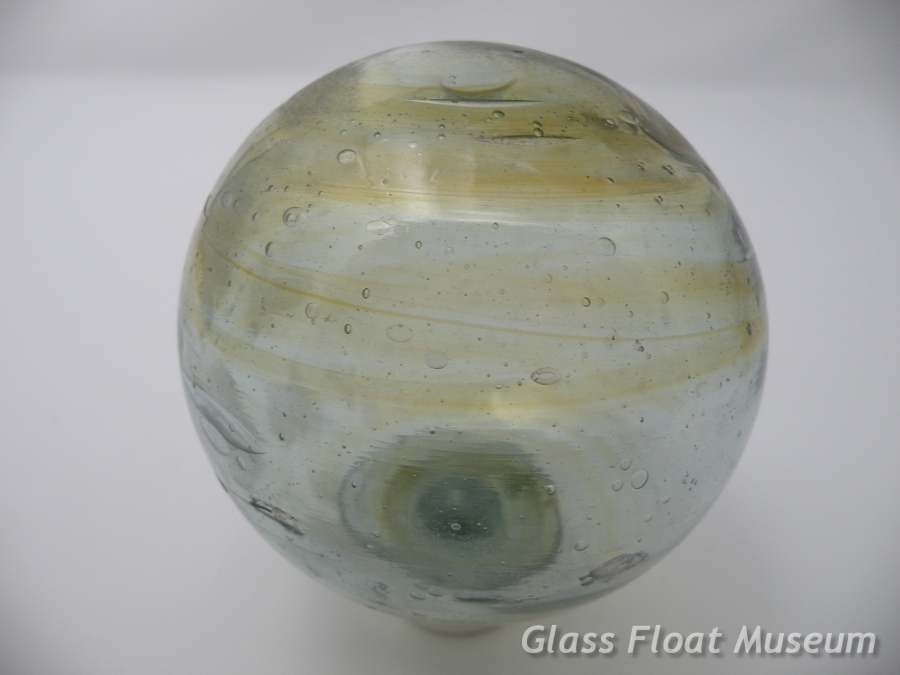
Keith Glein
This 3 inch float has an undocumented mark. The symbol appears to be a 'To' 斗 symbol. It's an 'X' with two dots in one of the quadrants 斗. This Kanji symbol means 'Big Dipper'.
There's also some light amber green swirls near the seal button that adds the attractiveness of this float.
This float was acquired from an antique seller located in Waianae, Hawaii.
Cranberry float that measures 2 1/2 inches in diameter.
This float is nicely netted.
Found on Hokkaido Island, Japan.
Free standing Spindle inside of a 4 1/4 inch float.
This float is a darker green color. Spindles in green floats are less common than the typical blue-green color.
Found on Hokkaido Island, Japan.
This Shark Roller is the 'thimble-shaped' ears version.
It's also a bit longer than the typical 6 inch shark roller by measuring 7 1/8 inches in length.
Bold, clear, and complete stamp of an 'O Under a Roof' maker's mark. This is an undocumented mark.
This mark began showing up on eBay in 2015. I've got a couple of them and have seen a few more for sale since then. I assume they came from a newly discovered cache of floats with this great looking mark.
All examples of this mark have been stamped on 5 inch floats.
This float was purchased from an antique seller located in Oregon.
Mark WP #63-A is 'Da' 田 under a roof. It's classified as a rare maker's mark.
WP #63-A is usually only found on 3 1/2 inch floats. This float measures 5 inches in diameter.
It may be the only known example of a WP #63-A stamped on a 5 inch float known to exist in a collection.
Found on Hokkaido Island, Japan.
Striking Cobalt Blue Swirls in a 3 1/2 inch float.
This float also has a classic 'green eye' in the middle of the seal button.
I think this is a exceptional example of a blue swirl float.
Found on Hokkaido Island, Japan.
This 7 inch float has two different maker's marks.
One is on the ID seal. There's a thick bold clear and complete stamp of WP #17 'Ao' 青 .
On the seal button, there's a lightly stamped version of WP #7-A 'Maru Se' ㊆.
I think it's pretty unusual to find two different stamps on separate seals, especially on an uncommon 7 inch sized float.
Excellent provenance ex-Col. Rich Richardson.
Found in Northern Japan.
Ro Purser’s first post about MILT floats: Hello Olga! Since you asked for information and history about this float I thought I would pop up and give you some information and history. I am the person that made that float over forty years ago. I hope you have taken Gary's advice and read the piece Tom Rizzo wrote about Milt and the way the floats came to be in the search section on this board. Tom did all he could to get it right!
I will explain the beautiful color. All the colors except brown and this green [I made other greens also] were achieved by adding metal oxides or carbonates to recycled window glass while being re-melted. Cobalt oxide for cobalt blue, Manganese dioxide for amethyst, copper carbonate for aqua blue etc. Since these were working floats to be in severe conditions I needed to use very strong glass. The type of glass used for "Freeblown Glass" is a 'softer' glass because of the ingredients used to make it able to be manipulated longer through the working temperature range. Window and container glass have a 'short' working range and are stronger due to less 'fluxes' being present. I needed to guarantee my floats against breakage to 500 fathoms to get them down to where the black cod live so I used the toughest glass I could. The green of your float was from glass I had imported from Holland. I suppose I could/should state that differently. I had a friend at the time with a tavern in my home town and I had him save all the empty Heineken beer bottles for me to melt for floats. Beer bottles are very strong and I also used brown beer bottles for the brown floats. Window glass is also very strong and withstands chemical attack as well. I certainly enjoyed coloring my floats and making them as interesting as possible.
When a fisherman wanted floats I would ask them what color they wanted. Quite a number of times the conversation would go something like this: Me…. "So Joe, what color would you like?………….. Joe……I don't give a s***………….. Well, you have a choice. I can make a number of different colors………….. I don't give a s***……….. But your wife might want to have some around the house to look at. She might have a choice……………… I don't give a s***……………. Well, what if someone steals some of your gear and you see your color float in somebody else's tubs or in a pile of gear on the dock?…………..pause………….. What colors do you have?…….. Most of the fishermen had one color but if they came back for more I would fill out orders from what I had on hand. That's the way the LoPasa floats came to be. Those were generally made for small or fill in orders. If someone bought 200 or over they got their name or the boat name on their own stamp.
It sure knocked me out to see that Milt float picture come up on my computer this morning. That is certainly a rare float and one of the first ones I ever made. Milt had the first order of 200 floats.
Congratulations! If you have any questions about my floats feel free to ask. Thanks, Ro
Ro Purser’s second post about MILT floats: Hello Olga! Your posting brought a smile as big as Texas to me this morning. I will try to answer your questions in order. I have talked to Milt a few times since I have been learning of the float collector community. We have had some great conversations about the way it all happened. He's in his 80s now. I have also talked to several of the other fishermen that bought the floats in the late 1970s and it has been a wonderful experience for me to again be in contact with the people that I respect the most in this world. Another coincidence that has put me in contact with the Eureka fleet again is that my youngest daughter has been fishing long line and salmon out of Eureka for about 8 years on boats I remember from my past. She has worked for three different people that used my floats in their youth. Milt and I think I made the first floats in 1976 or 77.
The fish was supposed to be a black cod but not an accurate depiction. I haven't blown any other floats in all these years except the ones I made for Frank and Teri last year. There are four reasons I made those few floats for Frank. [1] I respect him very much as one of the real life-long fishermen high-liners I miss from my past….. I know what it takes to be where he is and not many get there. [2] He is the person that opened my eyes to the current float community…. [3] He wanted to have a Lanola float for his dear wife Teri. I made those floats with art glass colors especially for her……… and [4] he happens to own the boat [my favorite] I was working on when I was 21 and decided to learn to blow glass. I walked off his boat and into the world of glass.
I'll never forget that first message he left on my phone. It ended with "I'd sure like to get a float with my boat name on it. It's only six letters long, L A N O L A…… I couldn't believe it. I about fell over. What are the odds that he would own that particular boat? How many boats are there on the west coast? He had been collecting my floats for many years when he finally figured out how to get in touch with me. He had found some of the most interesting floats I think I ever made. I couldn't wait to put the Lanola on a float though I've only made a few for him so far. I haven't made any floats for anyone else.
My career in glass has taken me many places over the last 40 years and I am still making my art glass for my living. You can see what I am currently doing on Facebook by going to 'Ro Purser Glass'. I think I am going to try to make some more floats next year though. I think in the end the floats are the most meaningful glass I have ever made. They put food on the table for the people I respect the most. I still have all the stamps and the float mold itself. I will be 70 years old then and even now can't put in the long days I did in the past. I've had carpal tunnel surgery on both wrists and have to pay attention to what I'm doing so it won't be high production. I intend to alter the stamps so there can be no confusion as to which floats were used in the past and which ones are new. I mean to get back into recycled glass like the originals and will still guarantee them down to 500 fathoms. They WILL be working floats. The original fishermen that I sold to that are still around have all given me their go ahead. Thank you for your questions Olga. I hope I haven't been too long winded in my reply.
From Tom Rizzo Facebook post (mentioned above): How often do you experience the wonder of yourself? Here we are, an immense number of Homo Sapiens, yet each one of us is unique. Each one of us has a different story to tell, and a path to follow. What happens to us on our individual paths, I believe, is an interaction between free will and the magic that exists for each one of us. The key to me, is to be aware of those two forces, and use them in order to collide with our destinies. I'm waxing philosophically today, because I do realize that having traveled my particular glass fishing float path, has presented me with so many wonderful people and experiences. During the last week, I ran into another traveler, Milt Pellegrini. Milt is very important, and I believe one of the most most important stories of why we now have Ro Purser's American Black Cod floats. Eventually, I will reveal the reason for his importance, but first, I wish to tell you a bit about Milt and the Pellegrini fishing family.
Milt is the third generation of five generations of Pellegrini fishermen and women. His great grandfather Virgilio Pellegrini, began Salmon fishing and catching Dungeness Crab with ring traps in 1910. Milt told me that on his wall, he has one of his grandfather's woven trays, used to coil the lines and hooks in. The boat he fished did not have a name, simply numbers. Virgilio's sons, Paul - Milt's father, was the captain and owner of the fishing boat "Sea Gull," and Milton, captain and owner of the fishing boat "Sportfisher II," were the 2nd. generation.
Milt could not tell me whether his grandfather did or did not fish for Black Cod, but his father and uncle both did. They also fished for Sharks, especially Soup Fin Sharks during the WWII years, and they used Northwestern Glass Co. floats on their gillnets and longlines, particularly the five and a half inch diameter size. After the war, and the creation of synthetic vitamins, fishing for sharks was not as good a business, but Black Cod fishing did become a good way to fill in the seasons between salmon and crab.
The fishermen out of Eureka, Ca. fished the Black Cod until about 10 years before Milt began. In the decade prior to Milt's trials, no one in his home port fished for the Cod, causing the fish and methods used to catch them to become almost forgotten. During a slow time, Milt thought about how his dad and uncle fished them, and made money between seasons, Milt had the idea to see if those fish were still around. Remembering how his father had rigged to longline the fish, he went to his Mom's house and retrieved whatever gear his father had used, especially the glass floats that were hanging around the house and yard. He even went to the old time fishermen to see if they still had floats, hooks, etc. Some did, and those old timers gave Milt their glass floats and gear.. He rigged up 9 tubs of line, hooks and glass floats, then made his 1st. set.
The next day, his son went with him to check the lines. The first five tubs of hooks and line retrieved were in a tremendous tangle - wrapped around a huge shark that had twisted and turned itself in the lines; but the other four were filled with nice fat Cod that sold for almost a thousand bucks. After that first venture, Milt continued to fish the cod between the salmon and crab seasons, and did quite well, but he was also losing gear that included the glass floats he had.
At that point in our conversation, I began to ask Milt questions about the floats, beginning with a question about the importation of Japanese and/or German floats for fishing. He told me that he knew nothing about that, and stressed that the Japanese floats were no good for deep water fishing - 200 fathoms or more. The glass was filled with bubbles, and the floats would burst. In need of more floats, he tried plastic floats from Norway. Those floats also burst under the tremendous pressure in the deep water where the Black Cod were most often found.
For a bit, I wish to veer off into a digression concerning the introduction and importation of glass floats from other countries to the West Coast. There were experiments in the late 1800's to use glass floats produced in the Northeastern states' glass houses, quite likely glassworks that operated in the area of Boston, for salmon in the Columbia River. Those experiments were mostly a complete failure, due to the swift currents and many rocks and boulders where the fish swam. Those early experiments with glass floats, evolved into the use of wooden floats, made mostly from the native Cedar trees.
There is information found in Amos Wood's book BEACHCOMBING FOR JAPANESE GLASS FISHING FLOATS, about importation of floats into the United States. He writes that Mr. E. S. Campbell, president of Northwestern Glass Co. told him that before the company started in 1932, hand-made green glass floats from Germany were "apparently the only source of supply at the time." Other than Amos's writing about what Mr. Campbell told him, I have been unable to verify the stories concerning the importation of Japanese glass floats. Back to Milt and the need to replace his cod gear, especially his glass floats.
Having heard about a local fellow who blew glass, he went to the guy. That guy was Ro Purser. Milt explained to him what he needed. As Milt and I continued talking about the memory of his first conversation with Ro, he told me that he brought a float for Ro to possibly duplicate. I asked him about that float. What he told me excited the heck out of me. Milt brought Ro a float that his father and uncle, then he had used in deep water for the Black Cod. That float became the pattern that Ro made his floats from. The float that Ro Purser's American Black Cod float was patterned on, was a four and a half inch diameter Northwestern Glass Co. float.
As we now know, instead of making a float with a raised neck seal, which is a machine-made float, Ro made his first floats with a standard seal. Ro's first float for the Eureka Black Cod fishing was beautifully embossed with a fish and the name "Milt". I have to ask if that fish is a Black Cod?
Standard Hokkaido roller with an extremely rare Spindle.
This is a very thick free standing spindle that spans across the barrel of the roller.
There's also a stamp of WP #10 'Rivermouth' on the seal.
Found on Hokkaido Island, Japan.
Light green float with yellow / gold swirls.
This 3 inch float is stamped with WP #80 '1'.
This float has excellent provenance. It was beachcombed in the Aleutian Islands by Paul Umlauf.
